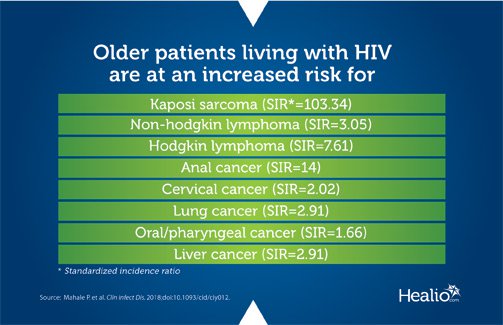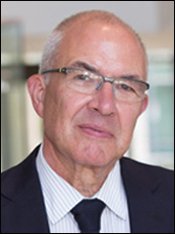Older patients with HIV at higher risk for cancer
Click Here to Manage Email Alerts
Older people living with HIV remain at an elevated risk for cancer, according to findings published in Clinical Infectious Diseases.
Although the relative risk for most cancers decline with age, the excess absolute risk (EAR) — a measure of absolute risk and a reflection of the number of excess cancers that occur among people living with HIV (PLWH) — increase with age for some non-AIDS-defining cancers (NADC), researchers reported.
“The introduction of highly active ART (HAART) has led to a steady increase in the life expectancy of PLWH,” Parag Mahale, MBBS, PhD, postdoctoral fellow at the National Cancer Institute, and colleagues wrote. “Consequently, the number of older PLWH in the U.S. has also increased.”
Rates of AIDS-defining cancers have declined over the past 20 years because of improved immunity due to HAART, but rates of many types of NADC increase with age, according to Mahale and colleagues.
“It is unclear whether age-related immune senescence in the setting of HIV-related immunosuppression will result in particularly elevated cancer rates among older PLWH,” they said.
The researchers reviewed data from the HIV/AIDS Cancer Match Study, which was conducted from 1996 to 2012, to evaluate the risk for various AIDS-defining cancers, such as Kaposi sarcoma, cervical cancer and non-Hodgkin lymphoma; and the risk for NADC, including Hodgkin lymphoma, lung, liver, anal, oral/pharyngeal, prostate, colon and breast cancer among PLWH aged 50 years or older.
The researchers compared cancer incidence rates between PLWH and the general population by calculating both standardized incidence ratios (SIRs) to measure relative risk, and EARs.
Mahale and colleagues reported 10,371 instances of cancer in 183,542 patients. The risk for breast cancer was reduced among PLWH compared with the general population (SIR = 0.61), as were risks for colon cancer (SIR = 0.63) and prostate cancer (SIR = 0.47), the researchers reported. However, risk was significantly increased for Kaposi sarcoma (SIR = 103.34), non-Hodgkin lymphoma (SIR = 3.05) and Hodgkin lymphoma (SIR = 7.61), as well as anal cancer (SIR = 14), cervical cancer (SIR = 2.02), lung cancer (SIR = 1.71), oral/pharyngeal cancer (SIR = 1.66) and liver cancer (SIR = 2.91).
Although SIRs for all cancers decreased with age, Mahale and colleagues wrote, EARs rose with age for lung, liver, oral/pharyngeal and anal cancers.
The risk for cancer was highest within the 5 years following HIV diagnosis, the researchers reported. Risk for non-Hodgkin lymphoma, Kaposi sarcoma, Hodgkin lymphoma and lung cancer decreased over time following HIV diagnosis.
“Despite lower relative risks, the absolute risk difference is higher for some NADC among older PLWH, leading to a greater incidence of excess cancers in this group,” Mahale and colleagues wrote. “Thus, there is a continued need for cancer prevention and early detection among older PLWH.” – by Andy Polhamus
Disclosures: The authors report no relevant financial disclosures.


